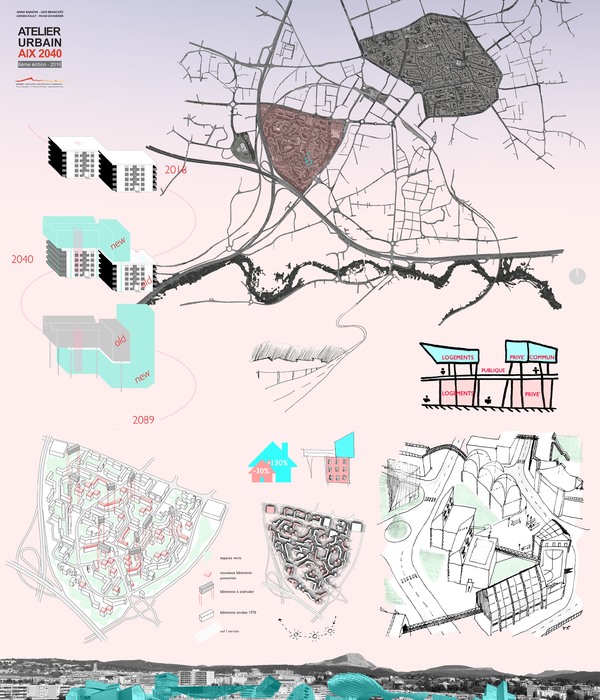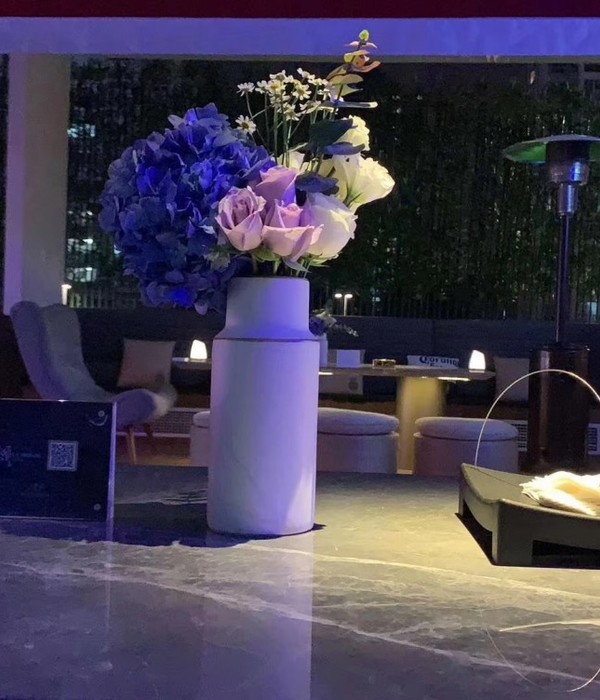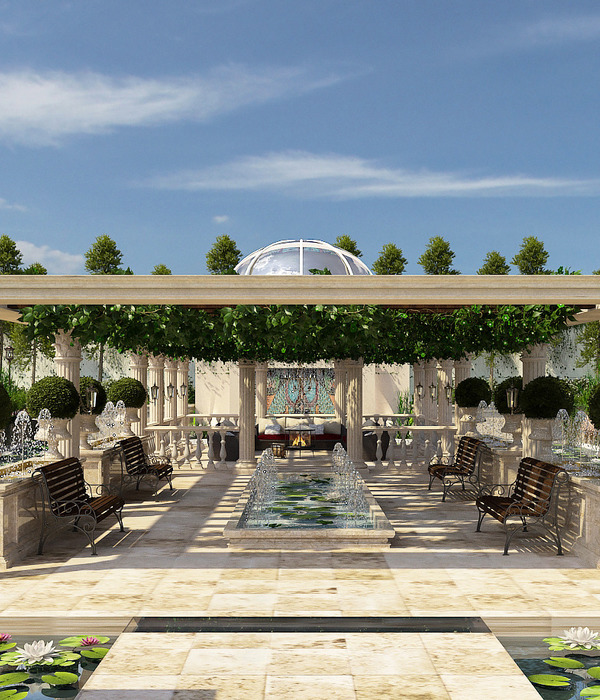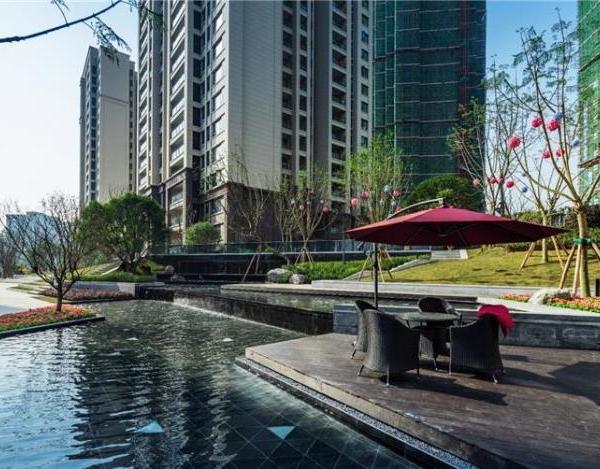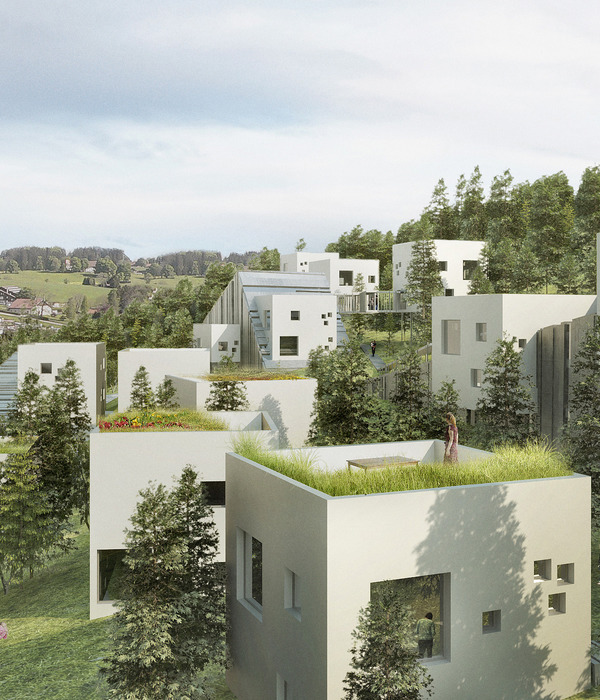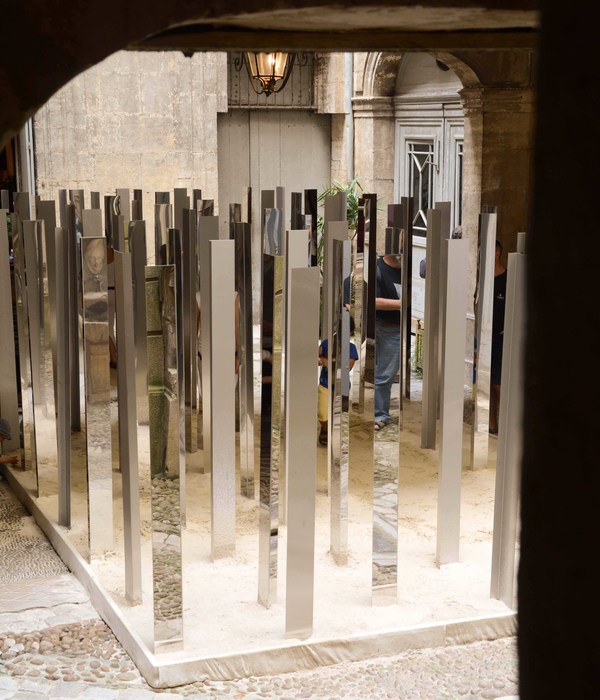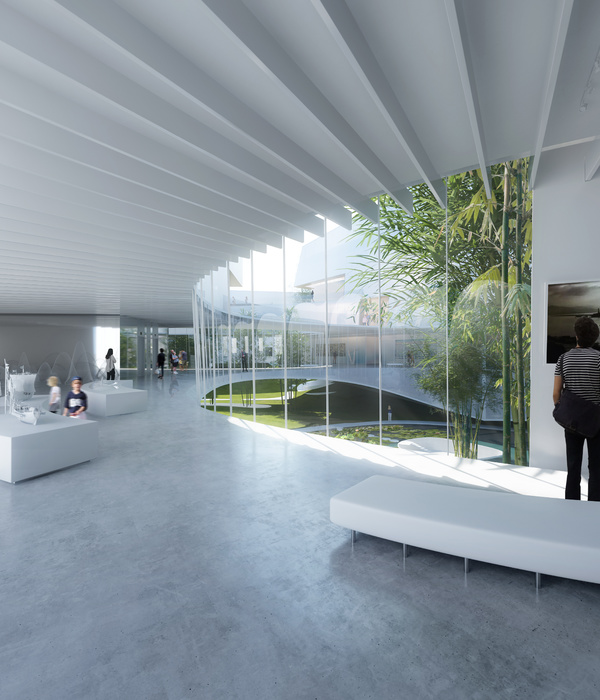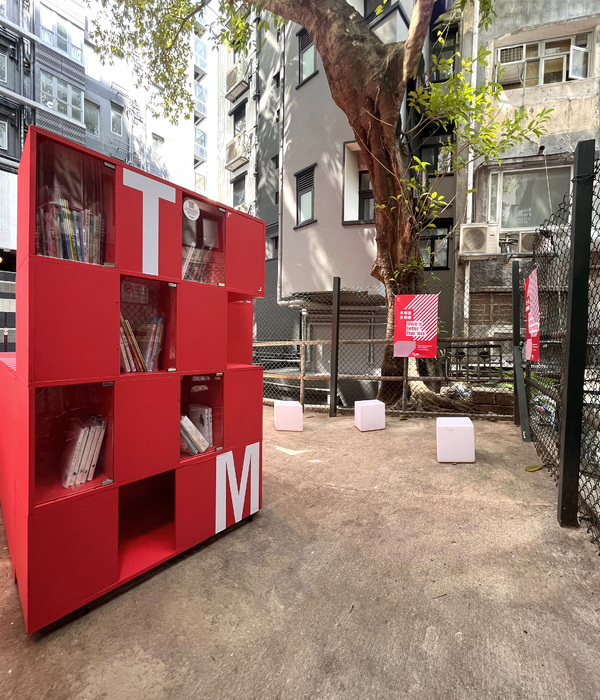bird view of Zaiwan village, a real normal village
照片 © Jin Weiqi
the floor painting methods of the main street and the streets are different
照片 © Jin Weiqi。
the main street after the upgrade
照片 © Jin Weiqi
04_色带、说明文字和装置与民居基底共同构建主街的叙事性景观。
照片 © Jin Weiqi
the floor painting of the main street
照片 © Jin Weiqi
the main street floor painting and street furniture, sometimes parallel, sometimes tangled
照片 © Jin Weiqi
the maze pattern on the street
照片© Jin Weiqi
children running along the floor painting
照片 © Jin Weiqi
the mouse drawn by a local kid in front of his family
照片 © He Wei
hopscotch
照片 © Jin Weiqi
the wall painting of streetlighting, reflect the village adding insulation
照片 © Jin Weiqi
street furniture began to integrate into country life
照片 © Jin Weiqi
signage, to record several key infrastructure upgrade projects
照片 © Jin Weiqi
Add historical stories’ marks on street furniture, revive culture
照片 © Jin Weiqi
game installation, floor painting, street furniture, and spontaneous construction together form a new landscape.
照片 © Jin Weiqi
the installation is an artistic continuation and enlargement of the relationship between the gas pipeline and the wall
照片 © Jin Weiqi
the village marker
照片 © Jin Weiqi
The bird view of Gallery of North Henan Folk Residence.
照片© Jin Weiqi
the facade of the health center after renovation
照片 © Jin Weiqi
street view of the gallery
照片 © Jin Weiqi
red bricks and black steel plates as the facade material
照片 © Jin Weiqi
the detail of the gallery facade © Jin Weiqi
entrance porch from the courtyard © Jin Weiqi
entrance porch © Jin Weiqi
western courtyard retains two old houses
© Jin Weiqi
The old and new buildings in the east yard form a confrontation.
照片 © Jin Weiqi
the outer corridor of the east courtyard
照片 © Jin Weiqi
the facade of the new building facing the courtyard is full-height glass
照片 © Jin Weiqi
rammed earth, red bricks and steel plates form a dialogue between materials and the times
照片 © Jin Weiqi
outdoor leisure area
照片© Jin Weiqi
Using the height difference of the site to form the fluctuation of the space
照片 © Jin Weiqi
keep the interior of the folk house and restore the life scene of the traditional folk house.
照片 © Jin Weiqi
The roof terrace not only expands the usable space, but also provides a higher perspective view of the building and surroundings.
照片 © Jin Weiqi
the bar can provide coffee and other drinks for the visitors
照片 © Jin Weiqi
the open area in the middle of the building is for the display and sales of cultural and creative products
照片 © Jin Weiqi
look at courtyards and old houses from the new building
照片 © Jin Weiqi
use a combination of roof tiles and vertical panels to make Double Happiness and Pisces pattern
照片 © Jin Weiqi
the bird view of the Square of Double Happiness and Pisces
照片 © Jin Weiqi
The convenience service station becomes pros which children are playing.
照片 © Jin Weiqi
the convenience service station viewing from the main street, the transformer station was wrapped inside the building
照片 © Jin Weiqi
bird view, the Square of Double Happiness and Pisces becomes public space in the village
照片 © Jin Weiqi
section of the Square of Double Happiness and Pisces convenience service station
图纸 © 3andwich Design
generative scheme of the Square of Double Happiness and Pisces
图纸 © 3andwich Design
site plan of the Square of Double Happiness and Pisces
图纸 © 3andwich Design
plan of the Northern Henan dwellings gallery
图纸 © 3andwich Design
图纸 © 3andwich Design
generative scheme of the Northern Henan dwellings gallery.
图纸 © 3andwich Design
site plan of the Northern Henan dwellings gallery
图纸 © 3andwich Design
site plan of the main street landscape design
图纸 © 3andwich Design
照片 © Jin Weiqi
照片 © Jin Weiqi
照片 © Jin Weiqi
照片 © Jin Weiqi
照片 © Jin Weiqi
照片 © Jin Weiqi
照片 © Jin Weiqi
照片 © Jin Weiqi
照片 © Jin Weiqi
照片 © Jin Weiqi
照片 © Jin Weiqi
照片 © Jin Weiqi
照片 © Jin Weiqi
照片 © Jin Weiqi
照片 © Jin Weiqi
照片 © Jin Weiqi
照片 © Jin Weiqi
建筑师:3andwich Design / He Wei Studio
位置:Seven Xian Town, Shuwu County, Jiaozhu City, Henan Province, Jiaozhu City, 中国
年份:2021
Background and original appearance: rural revitalization led by aesthetics and a three-no ordinary village. Xiuwu County, located in Jiaozuo City, Henan Province, belongs to the north of Henan. In recent years, it has vigorously advocated the path of rural revitalization led by aesthetics and achieved remarkable results. Zaiwan Village is a typical plain village in Qixian Town. The whole village was relocated in the 1960s, with the spatial structure in the shape of fish bone and no historical buildings. Lacking landscape, the village’s west side is close to the national highway, and the hills on the east belong to the military zone and are forbidden from entering. The village has no cultivated land or collective economy. The villagers are not poor, working either in the service industry at the Yuntai Mountain scenic spot or in nearby mines, but they lack endogenous power in the long run. Facing such a "three-no" village (no scenery, no style and features, no industry), how to improve it is a difficult problem: not only not to conform to the conventional pattern of simple painting and plastering, but also to give the village a new personality within the limited cost. Title elaboration: Museum of Living Style of the North Henan Folk Residence of the Past 40 Years Since the Reform and Opening-up. The architect found that the characteristics of the division of historic periods of the village houses were clear and existed in the form of "slicing". In addition, there were many traces of spontaneous construction, such as the colored steel shed and photovoltaic board, making the village appear chaotic but real, which is a living specimen of the changes of the residential buildings in northern Henan in recent years. If read from a deeper level, you will find that these marks also reflect the people’s spontaneous pursuit of a better life after the reform and opening-up, and the actual actions of the Party and the government to improve people’s livelihoods.
This project just hopes to sort out and enlarge the sample construction through aesthetic design, so as to make it clear and systematic.Planning and design conception: point-line-plane structure and the implementation pathThe planning and design is divided into several steps: first, the village texture and self-built traces are preserved to form the fundamental plane of the living museum. Then, the environmental health, village roads, spaces before and behind the houses, village lighting and so on are promoted as a whole, so as to provide better living conditions for the villagers. After that, a boutique visiting route and space nodes are created.The improvement of village infrastructure includes: white cement pavements changed to black asphalt pavement, greening increased, weak current cables buried into ground, original street lamps replaced with photovoltaic ones, walls of bare houses treated, and the sewer pipes dredged and hidden.The boutique visiting route is a "time axis", which connects the construction behaviors of Za iwan Village in the past 40 years. For the roads and walls, the design applies artistic treatment. And street furniture and game devices are added, so that it becomes the main site for villagers’ public life.In the important positions, space nodes are added, including: Gallery of North Henan Folk Residence, village marker, elevation transformation of the village health center, art device of Spring Blossoms, Square of Double Happiness and Pisces, etc. They form a node sequence with the village committee in the southern part.Narrative landscape and public art: improving the space quality by means of public art and landscape, with emphasis on narrative expressionThe new designed landscape and public art have strong narrative characteristics, which provide clues for reading this special museum and can be divided into four categories: pavement, wall, installation and street furniture.
The main north-south street is composed of three color strip graphics, yellow for gas pipeline, green for weak current line and blue for sewer pipeline, and together with explanatory text, the artistic narration of main street pavement is constructed. The design is based on the following: the "scars" left by the pipelines laying on the pavement for many times. The architect believes that these scars record the construction process, and can be transformed into graphic expression and form a special text. Street furniture is not only functional, but also the continuation of the pavement narrative, which is also in blue, green and yellow, and is connected with the ground color strips. The streets and lanes are relatively relaxed. Children’s paintings are selected, and there are also games loved by children, such as hopscotch and mazes. They provide a place for children in the village. The paintings on walls also emphasize artistic narration and interest. For example, as for the wall drawing of street lights, the architect found that there are many street lights in the village that protruded from the external walls of the building. So the theme of light and pole is drawn in corresponding position, suggesting the event of building insulation was added to cover the light pole. In the middle of the main street, a set of game devices are installed. Instead of high-tech and expensive materials, it’s been a simple set of pipes and microphones. It is the continuation and artistic expression of the village infrastructure pipelines. The new device is connected with wall drawings, original pipelines and color belt patterns painted on the ground to form the three-dimensional space narrative of wall and ground. Spatial nodes: stress in overall promotion and carrier of public activities Under the premise of the overall improvement of the village environment, the architect also set up nodes in important positions, which are also the main carriers of the village public activities in the future.
The village marker, located in the west side of Zaiwan Village, between the health center and the Gallery of the North Henan Folk Residence, can be seen from the national highway. The architect designed the village marker into a group of columns with different heights, which represents the development of Zaiwan Village is booming and rising. On the columns is a chronicle of events of the village, such as the founding of village, school building and other important moments.
The Gallery is transformed from two courtyards. The architect opened the courtyard and reserved three old buildings in the site, as the representatives of the folk residence in 1960s. On this basis, the streamline is re-sorted out and new buildings, entrance porches, corridors and outdoor rest space are added. The facade of the building is in the language of combination of red brick and black steel plate. The red brick is consistent with the courtyard materials of the 1960s nearby, and the metal plate indicates the contemporaneity. The elevation emphasizes the horizontal lines, which are flat and not noisy, but the plasticity of bricks is used in detail to form changes.
The main entrance is located in the courtyard on the west side, where the audience needs to enter circuitously. The main room and wing-rooms are reserved with proper repair and use as exhibition hall. The main room on the north side in the east courtyard is retained, with a new building added to the south. Its functions are coffee bar, tea room and cultural and creative products display and sale. The old and new buildings are in a state of opposite view and connected by the corridor on the west side. The old buildings keep the original rammed earth while the new buildings are red-bricked, and the traffic space is of black steel plates. The architect intends to make some positions form gaps. On the one hand, the conflict between the old and the new materials is avoided, and on the other hand, the dramatic role of light in space is strengthened.
In the interior layout, the old buildings are used as exhibition halls, preserving the original space pattern and properly restoring the historical features to reproduce the indoor life scenes in Northern Henan. The new building serves as a leisure and sales function, offering visitors a space for rest and exchange.
The Spring Blossoms is a landscape art device completed by the original Chinese toon tree in the village. The Chinese toon is located at the corner of the planned L-shaped boutique route, marking the starting point of the landscape of the north-south main street. The device symbolizes the beginning of Reform and Opening-up: spring returns to the earth, and everything recovers.
The Square of Double Happiness and Pisces is situated in the middle of the main street, formerly collective land where villagers planted vegetables. There was a substation and a grocery booth between the vegetable field and the streets. The architect transformed this area into a small square in the village for daily leisure use by the villagers. Firstly, the site was hardened to make it more suitable for the function of the square. Then, a notice board was added at one corner of the square and a rest platform at the other corner. Between the square and the main street, a new convenience service point was built to receive express delivery and serve as a small sales department. The original substation on the site could not be relocated. The architect transformed the exposed substation facilities into a safer box transformer and integrated it into the building, which is in harmony with the convenience service point. The service point has a trapezoidal plane with a wooden structure and a single slope roof. The southwest corner of the roof is higher, and the northeast corner is lower. The architect used the glazed tiles and facade of the roof to combine the "Double Happiness" and the Pisces patterns, representing the villagers’ good wishes for life.
Conclusion: a try to provide a sample of space promotion for ordinary villages. Villages like Zaiwan Village exist in quantity in Xiuwu County and even in whole China. They have no special scenery, no historical features, no significant industries, namely just ordinary villages with ordinary people and ordinary life. How to design them is a proposition that every architect engages in rural construction needs to think about. In Zaiwan Village, the design team was fortunate to find the theme of the Museum of Living Style of the North Henan Folk Residence of the Past 40 Years Since the Reform and Opening-up. On the basis of retaining the original texture, real rural landscape and spontaneous construction traces, the design team connected, enlarged and interpreted the village in the way of architecture, landscape, public art and narration. It is a kind of sneaking and also a kind of ingenuity. I hope it can provide reference for the revitalization of such ordinary villages in China. Project information: Location: Seven Xian Town, Shuwu County, Jiaozhu City, Henan Province. Owner: Qixian Town People’s Government of Xiuwu County. Architecture and landscape design: 3andwich Design. Leading architect: He Wei. Project architect: Liu Mingyang. Design team: Chen Long, Meng Xiangting, Wang Ziyi, Liu Yong, Zhao Dongyu (Internship), Wang Chenyu (Internship), Chen Mingxu (Internship). Resident engineer: Liu Weidong. Partners: Beijing Vage Architectural Planning and Design Institute Co., Ltd., Beijing Hongshang International Design Co., Ltd. Design time: Nov. 2020 - Jan. 2021. Completion time: May 2021. Photo: Jin Weiqi, He Wei.
{{item.text_origin}}

